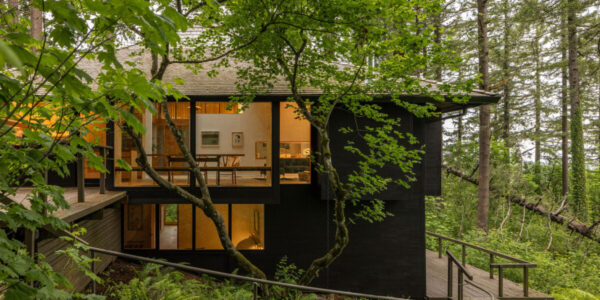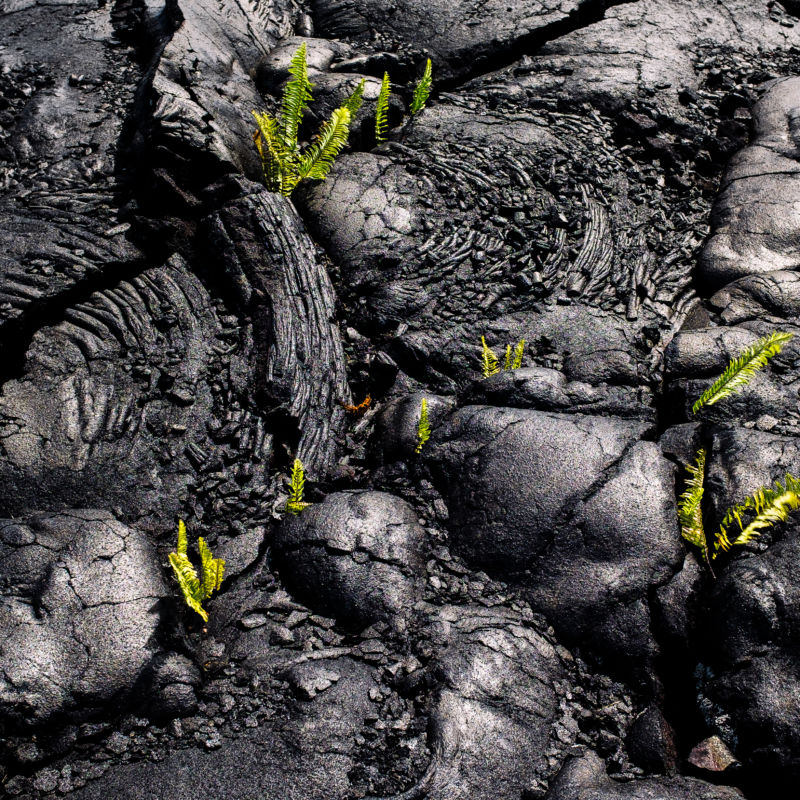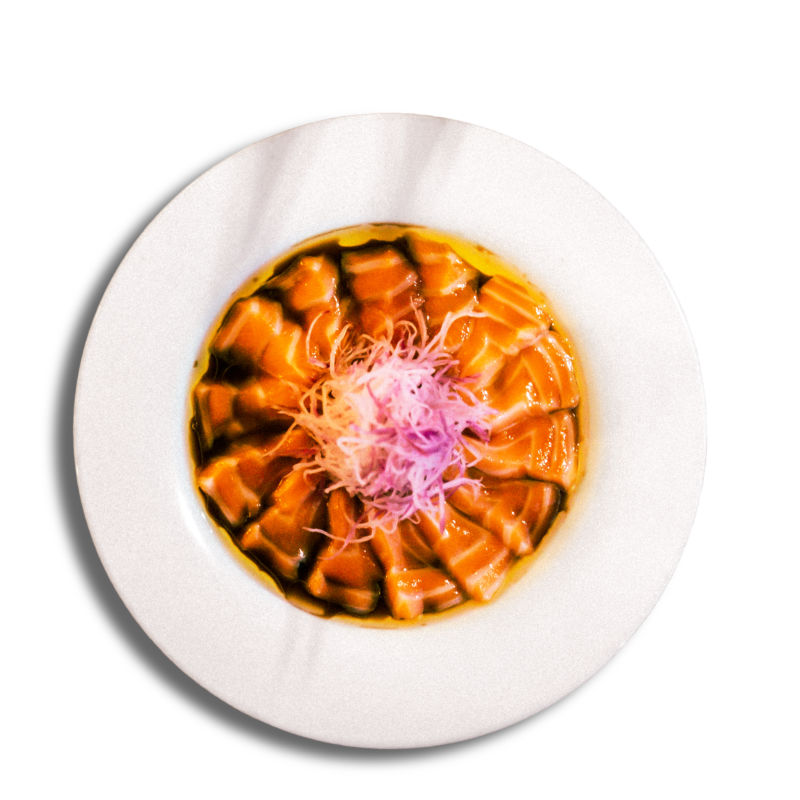
After the Flow: A Post-Kilauea Adventure on Hawaii’s Big Island
A family basks in the serenity restored to the Big Island following 2018’s catastrophic Kilauea eruptions.

A light rain falls on the emerald flank of Mauna Kea, the distant, cloud-crowned mountain that dominates the Island of Hawaii, the Big Island. 2018’s otherworldly Kilauea volcano eruption recedes into memory; it’s quiet, now, the grass tall and impossibly green, the far-off trees gauzy in the mist. This feels like a land born of water, not fire.
It reminds me of home, at least of one of them. When I was 10, my family relocated to Papua New Guinea. And that’s largely why we’re here in Hawaii. I wanted to introduce my young family to a landscape that resembles my old stomping grounds: trails winding through vine-strangled jungles, markets bursting with ripe mangoes and papayas, glassy coves with aquamarine water.
Leo, our 4-year-old, had his own ideas. A teary stand against active volcanoes meant we would start with something much less threatening: a farm tour at Kulaniapia Falls. If you want to make your kids fall in love with a place, we figure, it doesn’t hurt to start with animals.
Here on the rainy eastern side around Hilo, the scene is in sharp contrast to the sunnier, resort-studded western coast. Before the trip, my wife, Kristin, and I had downplayed last summer’s cataclysm, which leveled entire neighborhoods in the southeast corner of the island and quelled lei-seeking tourists en masse.

Thomas J. Story
Mary Chapman, who manages the property’s farm with her partner, Galen Alpine, hasn’t been here long, but she’s already laying the groundwork for a full-on farm-to-table concept for the Inn at Kulaniapia Falls. As she walks us through a nascent herb garden, Leo chases a stray chicken. His little sister Maxine, all of 18 months, naps on her mom’s chest. Leo pulls carrots from the ground to feed to the shaggy Icelandic horses lazing in a pasture. The mist comes and goes, and our shoes soak in moisture from the grass, but no one seems to mind. We’re starting to accommodate to the Big Island’s version of calm.

Thomas J. Story
The conversation takes a more somber turn as we approach the inn’s namesake waterfall. I ask Mary how she and Galen ended up here, and she explains that up until June, they had spent five years building an organic farm in Puna. If you followed the news of this past summer’s eruption, like I did, Puna will ring a bell: That’s the district where the recent lava flow burst forth, wiping out houses and fields and even the island’s most beloved tidepools.
“We were in denial until a mandatory evacuation was issued,” Mary says. The lava came slowly—much of the flows didn’t travel more than a few miles an hour—but it was unstoppable. “We had 15 acres,” she tells me. “It’s now under 100 feet of lava.”
For decades, Puna has been a place where free spirits and off-grid homesteaders move to tend the land. She tells me that many in that community—especially people who were raising families—decided they just couldn’t stand bringing up their kids in such an unpredictable place. Many left the island entirely. Others, like her, moved north and have begun to stitch together a new existence in the Hilo area. Those serene Icelandic horses? Turns out they’re refugees too, relocated from a pasture that’s now a plateau of shiny black rock.

Thomas J. Story
The geologic origins of the Big Island are hard to escape, no matter how far you are from the lava flow. For every upland farm, there juts black tongues of rock, like the craggy reminders poking out of a rock-strewn wash we have to cross to get to our glamping tent at Malulani Ranch. Eventually, we’re all (reasonably) comfortable with the idea of living on an active volcano, and we decide it’s time to visit one in earnest.
The most visited place on the island sits about 30 miles southwest of Hilo, the Hawai’i Volcanoes National Park. For the entire summer of 2018, the park was closed, as continuous eruption-related earthquakes shook buildings and destroyed roads and underground pipes. Yet, as ironic as it sounds, the park is not only open when we visit but also quieter than ever. Now that the long-building pressure has been released, Kilauea is as tame as it’s been in decades.
At the summit, a ranger tips us off about a paved road—still closed to traffic—that will allow us to take a stroller right to the edge of the crater. At first the path is just scraggly ’ōhi’a trees and a few scattered tourists. Then the trees begin to thin out, and we follow a metal plank across a two-foot-wide crack in the asphalt. The undergrowth is replaced by a field of little black pebbles, rock coughed up by past eruptions.
After a 20-minute walk, we see the crater gaping in front of us. A few vents are still letting off wisps of steam far below. Near the edge, we run into a tour group. I listen in as a guide explains: The lava lake in the bottom of the crater had been rising for the past 35 years before a series of earthquakes drained out the bottom about a year ago. As the crater emptied out, its sides began to collapse. He points to a shelf now resting hundreds of feet below the rim. “That’s Crater Rim Drive,” he says. Sure enough, if you look closely, you can still see the stripes on the asphalt.
The lava had to go somewhere, he continues, and the little Pu’u ‘Ō’ō vent—a smaller eruptive crater downslope that opened in 1983—wasn’t going to have nearly enough capacity to handle all the magma that was now headed east through the rift zone. It had to burst out somewhere else, and it did on May 3, as jets of steam and then fountains of lava began to course out of the ground at the Leilani Estates housing development. The eruption finally stopped on August 17, after covering nearly 14 square miles and turning Kapoho Bay into the newest piece of land in the United States.

Thomas J. Story
As traumatic as the recent lava flow was for those impacted, the turmoil is nothing new for native Hawaiians. In 1990, an eruption buried the entire town of Kalapana in southwestern Puna, for example—an occurrence all too often overlooked in breathless news reports of recent eruptions.
But not in the Airbnb listings: I happened upon a number of homes built on stilts anchored in shiny, whorled black lava. After the Kalapana lava flow cooled, intrepid homesteaders began rebuilding a community of sorts here. Why not experience the spare, stark end of the world?
We arrive a few hours before dusk, and the scene is even weirder than the pictures we’d seen online: boxy houses on stilts and an off-grid DIY compound or two that look like they came straight out of Mad Max. Here, it’s easy to imagine that you’re populating some advance outpost colonizing a barren extraterrestrial planet.
The Ohana House (pictured at top) is one of two neighboring structures designed by ArtisTree, a firm specializing in high-end tree houses. Like many of the newer buildings here, our temporary home can be moved on a flatbed truck if necessary, should a fresh lava flow come knocking.

Thomas J. Story
We hang out in the lanai that runs through the center of the small, two-bedroom house, taking in the Martian landscape, the breeze coming off the nearby ocean. Leo scans the horizon like an explorer. “Cool,” he says with a decisive nod, before escaping up the ladder to the bunk bed.
After we settle in, Jade—who manages the property—strolls over and we get to talking. “Pele called me here in 2011,” she says, before launching into a wild story about seeing double rainbows every morning for an entire summer. She now runs what she calls a “lava temple” next door, teaching yoga and leading spiritual classes in an open second-story room rich with incense and Buddha statues.
The lava used to be a big attraction here, when the Pu’u ‘Ō’ō vent was busy overflowing nearby. “For about a year and a half, you could sit here all night and watch the river of lava,” she tells me.
Things were busier back then—the road leading into the area was choked with cars, and food trucks fed the thousands of people who would make the miles-long hike to the lava. “I kind of miss it,” she says.

Thomas J. Story
The quiet expanse of the flow is meditative—and welcome. A caravan of cars would easily shatter this peace. I’m fascinated by the sleek lava crumpled like a thick quilt. In some sheltered overhangs strands of “Pele’s hair”—bits of lava blown into fine, glassy threads as they cooled—have been resting undisturbed since 1990. In most of the crevasses, lime green ferns pop out, providing vibrant splashes of color amid the blackness. Here and there, soil has been packed into nooks and crannies, and pineapples and avocado trees have taken root.
The next afternoon we drive down the coast in hopes of reaching the most recent lava flow. We’ve heard there’s already a new black sand beach on its western flank, in Isaac Hale Beach Park. But we’re stymied by a roadblock, so we retrace our path back to our old lava flow. “Every time we drive back onto the lava,” my wife says out of the blue, “I feel like we’re coming home.”

Thomas J. Story
Weeks later, back in our more permanent home of San Francisco, Leo’s volcano obsession kicks into high gear. We watch YouTube videos of bursting lava fountains as he tries to understand Pele. Does Pele make the lava? Why does Pele like to destroy things?
I point out the duality of nature, the restorative nature of the lava, but Leo insists: “Volcanoes only DESTROY!”
Then, finally, a breakthrough: a video about Kilauea’s recent eruptions explains that without volcanoes, there would be no Hawaiian Islands. Where the lava flows into the sea, the island itself expands.
He looks up from his table with a surprised look on his face.
“I guess we were both right,” he says. “Lava creates and destroys.”
My point all along, I think to myself. But sure—I’ll give him half the credit.

Thomas J. Story
Ways to Experience Kilauea
HIKE: Haʻakulamanu
The 1.2-mile path takes you through colorful mineral deposits, wildflowers, and steaming vents.
HELICOPTER TOUR: Paradise Helicopters
Observe the mystical Kilauea volcano from above, from the river of frozen lava to the newest black-sand beaches. It’s a bird’s-eye view of one of Earth’s most spectacular creations.
PHOTO TOUR: Epic Lava Volcano Park Private Tour
Capture the glowing volcano under the stars during an intimate photo tour of the best locations for nighttime and sunrise photography. From 2 a.m. to 7 a.m., you’ll get tips on how to snap like a pro.

Thomas J. Story
HILO GUIDE
STAY
Ohana House
Nestled at the foot of the world’s most active volcano, the Ohana House is a custom-made two-bedroom “tiny house” surrounded by black lava. Just a 20-minute walk from the ocean, this minimalist home gives guests epic views of the volcano and easy access to hiking trails.
Inn at Kulaniapia Falls
The husband-and- wife owners of the Inn at Kulaniapia Falls embrace a farm-to-table ethos, growing most of the inn’s food on-site. Only 15 minutes from town, the off-the-grid B&B consists of multiple Asian-inspired buildings; request a room with views of the property’s privately accessible waterfall.
Malulani Ranch
Glamp in nirvana at Malulani Ranch, which rests on 17 acres of native koa and ʻohia forest, prairie grass, and wild orchids. Just 5 miles outside of Hilo town, the site offers a 16-inch Hawaii Belle tent, a covered kitchen, and outdoor showers.
EAT
Moon & Turtle
Hawaii isn’t lacking in restaurants that use local ingredients, but this is the place to truly get to know the island’s farm- and ocean-to- table scene. Menu favorites like the Smokey Sashimi and whole-fried menpachi have a habit of selling out fast, so reserve a table and cross your fingers. 808/961-0599
Poke Market
This downtown spot is happy hunting ground for poke purists. Set up as a to-go shop, the Waianuenue Avenue market sells poke by the pound or over rice and topped with add-ons like purple sweet potato salad. 808/961-5915
Puka Puka Kitchen
A Hawaiian plate lunch is best served at a place like this, where it’s very much about the food and very little about how pretty the restaurant is inside. Who needs Instagram-friendly wallpaper when you’ve got garlic rice this good, anyway? 808/933-2121
DO
Isaac Kepo’okalani Hale Beach Park
The Kilauea eruption created the island’s newest black-sand beach inside the park, which reopened to the public in December. Nicknamed “Pohoiki” by Hawaii residents, this locals’ spot isn’t jammed with tourists…yet.
This beach is a popular hangout for families, thanks to its sand-bottomed cove. Novice swimmers can rest easy knowing there are few if any waves since the water is separated from the ocean by a boulder break. You’ll find tidepools here too, where sea-turtle sightings aren’t out of the ordinary. The turtles are protected so look, but don’t touch.
With its untamed waves, pebbly beach, and lack of a designated parking lot, Honoliʼi isn’t made for relaxing family outings, but it’s paradise for surfers—the black-sand beach attracts the island’s surf crowd. –Maya Wong and Kelsey Maloney
Read the Current Issue Here!
Get one year of Sunset—and all kinds of bonuses—for just $29.95. Subscribe now!
